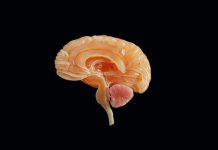
In a new study, researchers found that Alzheimer’s disease in its early stages affects the integrity of small blood vessels in the retinas of patients.
This discovery holds promise for early diagnosis of Alzheimer’s through the retina, a back-of-the-eye organ that is an extension of the brain and easily accessible for live, noninvasive imaging.
The research was led by Cedars-Sinai scientists.
Alzheimer’s disease is the leading cause of dementia and is characterized by a severe decline in memory and mental ability serious enough to affect daily life.
It is estimated to affect more than 5.5 million people in the U.S., including about 10% of adults age 65 or older, and the incidence is rising, according to the Alzheimer’s Association. Alzheimer’s is presently incurable.
The team found early molecular and cellular loss in blood vessels together with the accumulation of amyloid-beta deposits, a buildup of a toxic protein, in retinal blood vessel walls of Alzheimer’s patients.
The buildup of this protein in the brain is a signature of Alzheimer’s.
The team was able to map these vascular abnormalities and find that certain regions of the retina were more vulnerable.
In the study, the team examined 62 post-mortem eye tissues of 29 patients who had Alzheimer’s, 11 patients who had mild cognitive impairment-an early stage of Alzheimer’s that precedes dementia-and 22 individuals with normal cognition.
In the Alzheimer’s patients, the study found three abnormalities within tiny blood vessels in their retinas: high death rates for pericytes, a type of cell that lines the vessels; low levels of PDGFRβ, a protein receptor that promotes development and growth of cells; and accumulation of toxic amyloid-beta forms.
Among many functions, pericytes help regulate blood flow and maintain the blood-brain barrier that protects the brain from toxins.
The team says it appears that amyloid-beta deposits in the blood vessels and the lack of PDGFRβ are strongly linked to pericyte degeneration in the Alzheimer’s retinas.
In addition, the researchers found the most toxic forms of amyloid-beta building up within the pericytes themselves. These changes mirrored those in the brains of the patients.
The study indicates that retinal pericytes underwent early programmed cell death in Alzheimer’s patients.
Deficiency in vascular PDGFRβ was tightly connected with increased brain levels of amyloid-beta buildup, including on the walls of brain arteries, and loss of cognitive function in those patients.
The retinal abnormalities detected in the new study also were found in patients with mild cognitive impairment.
Taken together, these findings offer significant insights into how Alzheimer’s develops, with major clinical implications.
The next step for the researchers is to pursue further development of noninvasive high-resolution retinal imaging, potentially targeting pericytes and the molecular changes they discovered in blood vessels, as a means to diagnose Alzheimer’s.
One author of the study is Maya Koronyo-Hamaoui, Ph.D., associate professor of Neurosurgery and Biomedical Sciences at Cedars-Sinai.
The study is published in Acta Neuropathologica.
Copyright © 2020 Knowridge Science Report. All rights reserved.



